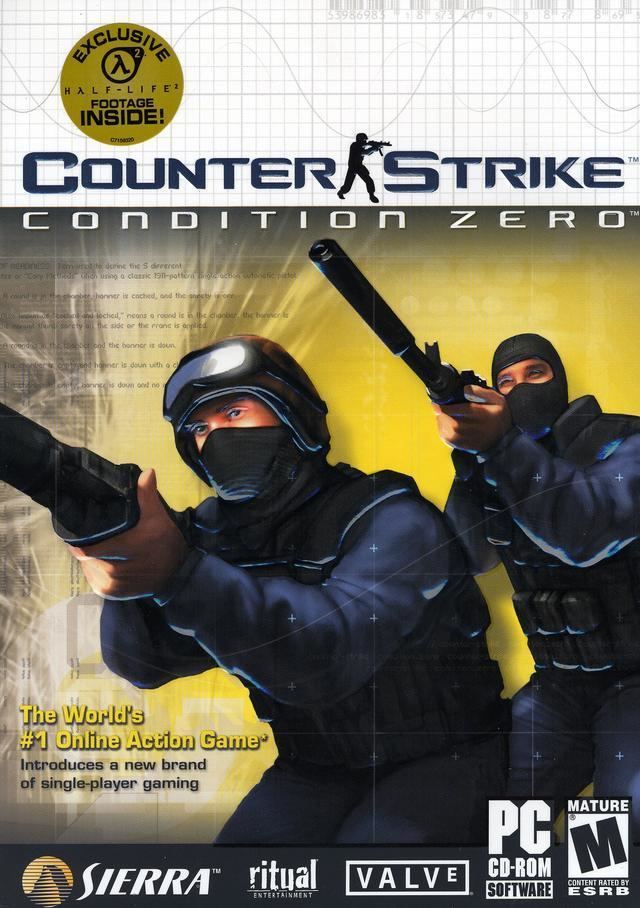9 /10 1 Votes9
Composer(s) Zak Belica Initial release date 23 March 2004 | 9/10 Steam | |||||||||||||||||||||||||||||||||
 | ||||||||||||||||||||||||||||||||||
Distributor(s) Vivendi Universal Games Release date(s) WindowsWW: March 23, 2004OS X, LinuxWW: March 6, 2013 Similar Counter-Strike games, Valve Corporation games, First-person shooter games | ||||||||||||||||||||||||||||||||||
Counter strike condition zero mission 1
Counter-Strike: Condition Zero is a multiplayer video game, the follow-up to Counter-Strike. The game was released in 2004 using the GoldSrc engine. Condition Zero features a multiplayer mode, which features updated character models, textures, maps and other graphical tweaks. It also includes two single-player campaigns, including Condition Zero: Deleted Scenes.
Contents
- Counter strike condition zero mission 1
- Counter strike condition zero stadium normal hd
- Development
- Condition Zero Deleted Scenes
- Reception
- References
Alongside various other Valve titles, the game received versions for OS X and Linux in 2013.
Counter strike condition zero stadium normal hd
Development
Condition Zero started development in 2000 by Rogue Entertainment, and was initially announced in May 2001 at E3 of that year. Rogue's producer for the game, Jim Molinet, later that year moved to Sony and the development company went defunct, leaving Valve empty. Later, they gave it to Gearbox Software, the developers of the Half-Life expansion packs, so that Valve could focus on the development rival Team Fortress 2 and its new engine.
Gearbox created an overhaul of Counter-Strike with high quality models and improved graphics. They also added alpha blending, allowing for realistic foliage and weather effects, a single-player mode to the game, similar to the final game, based on inspiration of Randy Pitchford from console games such as Tony Hawk's Pro Skater and Gran Turismo 3: A-Spec, and they included explosive weapons such as a Molotov cocktails, tear gas bomb, and M72 LAW rocket. They also used the release of Steam to their advantage to help prevent cheating by ensuring constant code updates.
After a few developmental delays, it missed its late 2002 deadline and was given over to Ritual Entertainment, who completely remade the game into a single-player one with 20 unconnected missions. It was expected to be released in early 2003 with a secondary multiplayer mode by the upstart Turtle Rock Studios, and released alongside the Xbox version of Counter-Strike.
However, after declaring the game gold and handing out review copies of Ritual's work, Valve saw an average review score of around 60%. The companies retracted the gold status and work on Condition Zero was essentially begun again. Ritual's share of development was dropped, and Valve assigned Turtle Rock to finish development. They implemented a new bot AI that was beta tested in Counter-Strike 1.6 before release. The final game contained a version mirroring Gearbox's version, along with 12 missions recovered from Ritual's single-player portion, called Deleted Scenes.
Condition Zero: Deleted Scenes
Condition Zero: Deleted Scenes is what is left over from Ritual Entertainment's stage of development, a series of eighteen unconnected single-player missions.
Deleted Scenes was originally the focus on the game with standard multiplayer included. However, after declaring the game gold and handing out review copies of Ritual's work, Valve saw an average review score of around 60%. The companies retracted the gold status and work on Condition Zero was essentially begun again. Ritual's share of development was dropped, and Turtle Rock Studios eventually made its own version. The final game contained Ritual's single-player portion, called Deleted Scenes, along with Turtle Rock's version.
Several weapons from the "lost co" have made an appearance in Deleted Scenes, including the M72 Light Anti-Armor Weapon, and the M60 machine gun. Some are limited to the AI terrorists, such as the machete and Rogue Entertainment's controversial suicide belt. Some reconnaissance weapons including the blow torch, radio, fiber-optic camera and remote control bombs. Players can also carry up to three grenades instead of the usual one. Moreover, the power of players' Kevlar Armor is boosted, better protecting players from many projectiles and bullets.
Some weapons were completely reanimated. This includes the Colt, M4A1, AK47, FAMAS and Galil with the exception of the SIG SG 552 which uses its "beta animations". Weapon textures are also slightly modified. The weapons are colored a bit differently from their Counter-Strike counterparts, such as the Arctic Warfare Magnum which is now brown instead of green, the Steyr AUG and the Colt M4 carbine are now two-tone police black instead of the usual colors. It initially came with twelve missions, but later Steam updates added six additional missions that were cut from the initial release. There is a small community for Deleted Scenes, and a few custom maps have been released.
Reception
Condition Zero received mixed to average reviews, receiving an aggregate score of 65 on Metacritic. The game was praised for its AI and new maps, while it was criticized for being out-of-date following its lengthy development.
